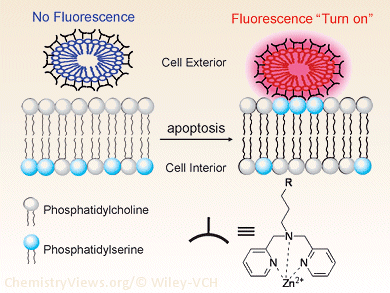Programmed Cell Death
Programmed cell death, or apoptosis, occurs tens of millions of times every day in every human body. Researchers in South Korea have devised an easy method to detect apoptotic cells by fluorescence, as they report in Chemistry—An Asian Journal. Their method makes it easier to detect improper biological regulation of apoptosis, which can lead to neurodegenerative diseases, autoimmune diseases, and cancer.
Apoptosis is involved in macroscopic developmental processes as well. For example, in an embryo, the cells between fingers die by apoptosis to form individual digits, and the tail of a tadpole is resorbed by apoptosis when it metamorphoses into a frog.
Fluorescent Detection of Apoptotic Cells
Upon apoptosis, the relative composition of the outside and inside of the cell membrane changes, and one component, phosphatidylserine (PS), migrates from the interior to the exterior. Kyo Han Ahn and collaborators at Pohang University of Science and Technology designed an artificial membrane vesicle that fluoresces when it interacts with PS. This so-called liposome is held together by a polydiacetylene backbone and is decorated with zinc atoms at its periphery. The zinc atoms interact with PS but not with other components of the cell membrane. This interaction distorts the shape of the backbone, causing fluorescence of the liposome. The “turn on” effect eliminates washing steps to remove extra fluorescent marker, making the method easy to use. The selectivity of the interaction means that only apoptotic cells are marked fluorescently. Microscopy images show that the fluorescence is localized on the cell surface, confirming the mode of interaction between liposome and PS.
- Turn-On Fluorescence Detection of Apoptotic Cells Using a Zinc(II)-Dipicolylamine-Functionalized Poly(diacetylene) Liposome,
Yong-Suk Cho, Kyung Mi Kim, Duhwan Lee, Won Jong Kim, Kyo Han Ahn,
Chem. Asian J. 2013.
DOI: 10.1002/asia.201201139




